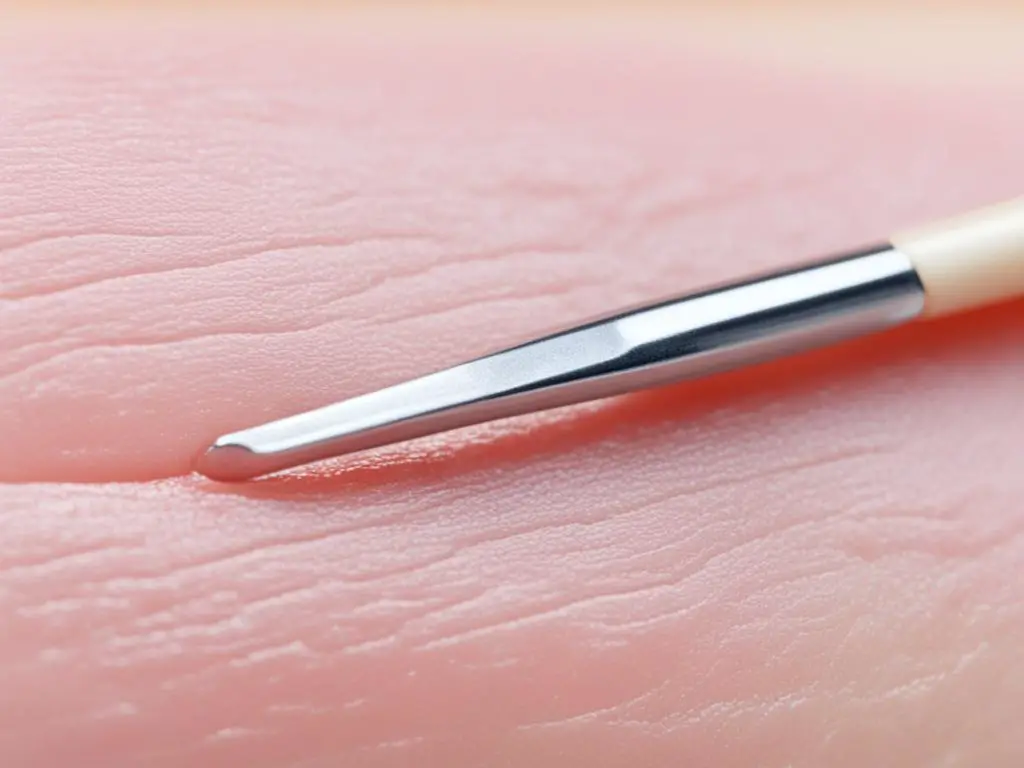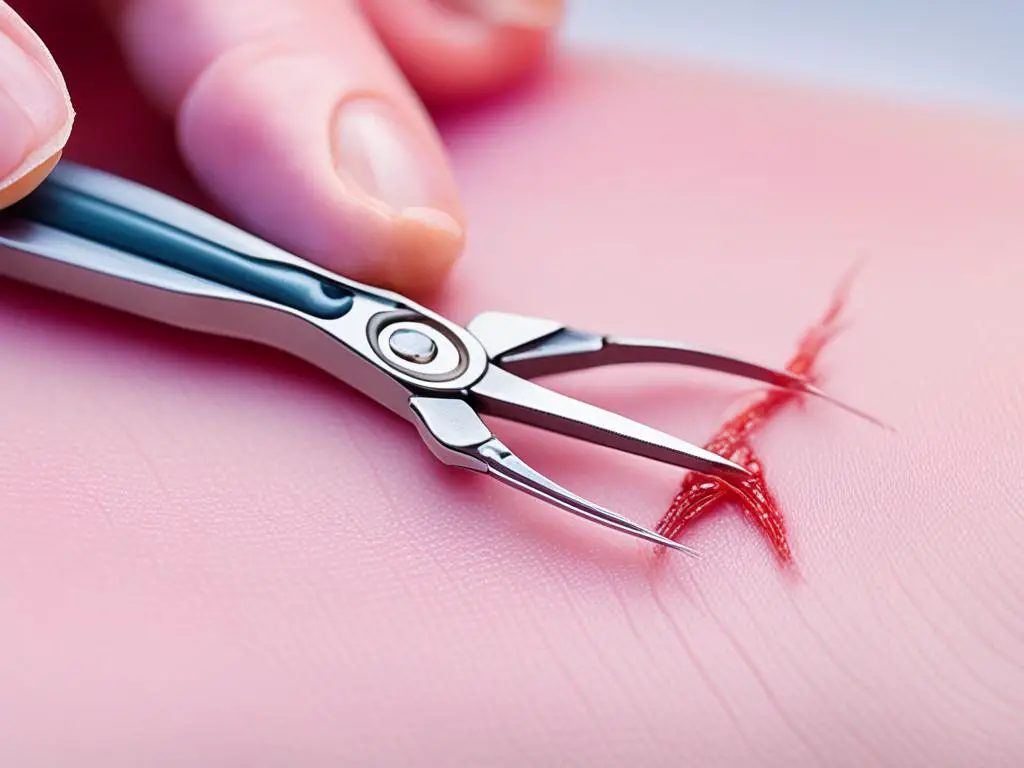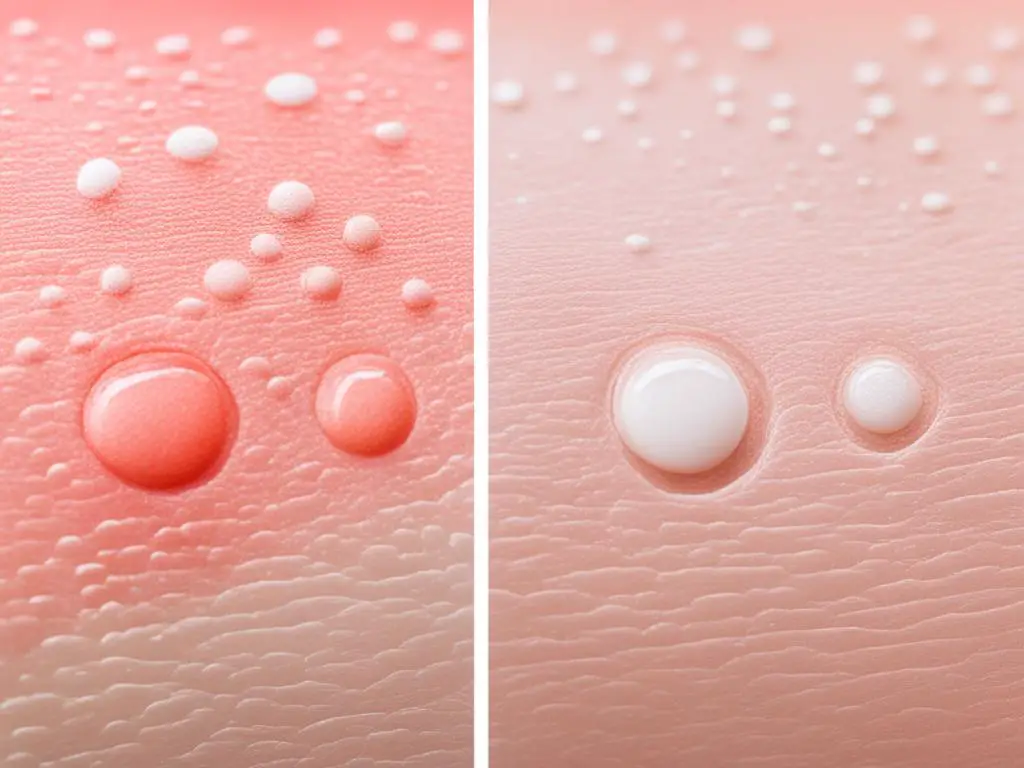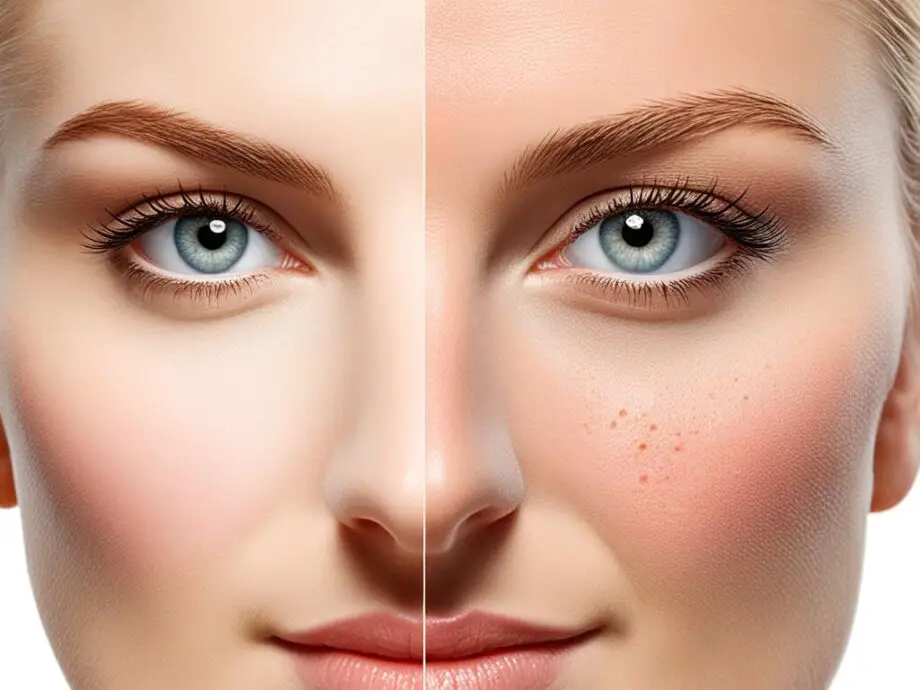Welcome to our comprehensive guide on milia and skin tags – two common skin conditions that may appear on your face and body. In this article, we will explore the differences between milia and skin tags, including their causes, treatment options, and prevention methods. By understanding these distinctions, you can effectively maintain clear and healthy skin.
Key Takeaways:
- Milia are small, white cysts caused by trapped dead skin cells or keratin.
- Skin tags are flesh-colored growths that often occur where the skin rubs together.
- Milia can be removed through professional extraction or by using topical treatments.
- Simple remedies like tying off skin tags or freezing them can aid in their removal.
- Prevention methods for milia and skin tags include proper skincare and avoiding prolonged friction on the skin.
What are Milia?
Milia are small, white cysts that often appear on the face, particularly around the eyes, nose, and cheekbones. These tiny bumps are caused by trapped dead skin cells or keratin, a protein found in skin and hair.
Milia can be a cosmetic concern for many individuals, but they are generally harmless and do not cause any pain or discomfort. However, if you’re bothered by their appearance or wish to prevent their occurrence, there are various removal, treatment, and prevention methods available.
The Causes of Milia
The development of milia is usually attributed to the following factors:
- Excess oil production
- Dead skin cell buildup
- Injury or damage to the skin
- Prolonged sun exposure
- Certain skin care products
Understanding the underlying causes of milia is essential in effectively treating and preventing their recurrence.
Removal and Treatment Options
While milia typically resolve on their own over time, some individuals may opt for removal methods to speed up the process or for cosmetic reasons.
Common milia removal methods include:
- Extraction by a dermatologist or skincare professional
- Laser treatment
- Chemical peels
- Microdermabrasion
It’s important to consult with a qualified professional to determine the best course of action for your specific case.
Prevention Tips
To prevent milia and maintain clear, healthy skin, consider the following tips:
- Keep your skin clean and well-moisturized
- Use non-comedogenic skincare products
- Avoid excessive sun exposure and use sunscreen
- Practice gentle exfoliation
- Avoid picking or squeezing milia
By following these preventive measures, you can reduce the likelihood of milia formation.

| Milia Removal Methods | Effectiveness | Downtime | Cost |
|---|---|---|---|
| Extraction | Highest | Minimal | Varies |
| Laser treatment | High | Minimal | Varies |
| Chemical peels | Moderate | Variable | Varies |
| Microdermabrasion | Moderate | Variable | Varies |
Understanding Skin Tags
Skin tags, also known as acrochorda, are small flesh-colored growths that typically appear in areas where the skin rubs together, such as the neck, armpits, and groin. These benign skin growths often go unnoticed or are dismissed as cosmetic nuisances. Although they are generally harmless and painless, skin tags can sometimes become bothersome or impact self-confidence.
While not fully understood, skin tags are believed to develop due to various factors, including:
- Friction: Skin rubbing against skin or clothing may contribute to the formation of skin tags.
- Age: Skin tags are more common in middle-aged and older individuals.
- Hormonal changes: Pregnancy and hormonal imbalances may increase the likelihood of skin tag growth.
- Genetics: There may be a genetic predisposition to developing skin tags.
While skin tags are generally harmless and don’t require treatment, many individuals choose to remove them for cosmetic reasons. Several removal options include:
- Cutting: A dermatologist can quickly and safely remove skin tags by cutting them off with surgical scissors or a scalpel.
- Cauterization: This procedure involves burning off the skin tag using heat or electrical current.
- Cryotherapy: Liquid nitrogen is used to freeze the skin tag, causing it to fall off.
- Ligation: This method involves cutting off the blood supply to the skin tag by tying it off with a small string or thread.
To prevent skin tags, it can be helpful to practice good skincare habits:
- Keep skin clean and dry: Maintaining proper hygiene can minimize friction and reduce the likelihood of skin tag formation.
- Avoid tight clothing: Wearing loose-fitting attire can reduce friction and irritation.
- Manage weight: Maintaining a healthy weight can help prevent skin tags in areas prone to rubbing, such as the neck and underarms.
- Regularly inspect your skin: By regularly checking for new growths or changes in existing skin tags, you can seek timely medical advice if necessary.
It’s important to consult with a dermatologist or healthcare professional for personalized advice and treatment options based on your specific skin tag concerns.
| Treatment Method | Pros | Cons |
|---|---|---|
| Cutting | Immediate removal | Possible scarring, minimal discomfort during the procedure |
| Cauterization | Quick procedure, minimal bleeding | Possible scarring, mild pain or burning sensation during the procedure |
| Cryotherapy | Non-invasive, no scarring | May cause temporary skin discoloration, slight discomfort during the freezing process |
| Ligation | Painless, no scarring | Takes longer for the skin tag to fall off, potential discomfort from the tied-off area |

The Differences between Milia and Skin Tags
Although both milia and skin tags are common skin conditions, they have distinct characteristics and require different treatment approaches. Understanding the disparities between these two conditions can help you identify and address them effectively.
Milia
Milia are small, white cysts that often appear on the face, particularly around the eyes, nose, and cheekbones. These tiny bumps are caused by trapped dead skin cells or keratin, a protein found in skin and hair.
- Milia Removal: It is best to avoid trying to remove milia at home as improper extraction may lead to scarring or infection. Consult a dermatologist for professional milia removal.
- Milia Treatment: Depending on the severity of the milia, treatment options may include chemical peels, microdermabrasion, or cryotherapy.
- Milia Prevention: Exfoliating regularly, using non-comedogenic skincare products, and protecting your skin from sun damage can help prevent the formation of milia.
Skin Tags
Skin tags, also known as acrochorda, are small, flesh-colored growths that usually occur in areas where the skin rubs against itself, such as the neck, armpits, and groin. While they are harmless, skin tags can be bothersome or cosmetically undesirable for some individuals.
- Skin Tag Removal: Skin tags can be removed through various methods, including freezing (cryotherapy), cauterization, or surgical excision. Consulting a healthcare professional or dermatologist is recommended for safe removal.
- Skin Tag Treatment: Most skin tags do not require treatment unless they cause discomfort or inconvenience. Over-the-counter creams or herbal remedies may help reduce the appearance of skin tags.
- Skin Tag Prevention: To minimize the risk of skin tag development, maintaining good hygiene, avoiding tight-fitting clothing, and maintaining a healthy weight can be beneficial.
By comparing the characteristics, causes, and treatment options of milia and skin tags, you can distinguish between the two and seek appropriate care when needed. Remember that seeking professional advice from a dermatologist or healthcare provider is essential for accurate diagnosis and effective management of these skin conditions.
| Milia | Skin Tags |
|---|---|
| Small, white cysts | Small, flesh-colored growths |
| Caused by trapped dead skin cells or keratin | Often occur in areas with skin friction |
| Professional removal recommended | Various removal methods available |
| Treatment may involve chemical peels or cryotherapy | Typically no treatment necessary unless desired |
| Exfoliation and sun protection can help prevent milia | Maintain good hygiene and avoid tight clothing for prevention |

Conclusion
Understanding the differences between milia and skin tags is essential for effective management of these common skin conditions. Whether you’re dealing with milia or skin tags, it’s important to consult with a dermatologist or healthcare professional for personalized advice and treatment options.
When it comes to milia, the key is to gently exfoliate the skin and keep it well moisturized to prevent the buildup of dead skin cells. In cases where milia do not resolve on their own, a dermatologist can perform professional extraction or recommend topical treatments.
Skin tags, on the other hand, can be removed through various methods, including cryotherapy, ligation, or excision. However, it’s crucial to remember that attempting to remove skin tags at home can lead to infection or scarring. Always seek professional guidance for safe and effective removal.
By maintaining a regular skincare routine and practicing good hygiene, you can prevent both milia and skin tags from developing or worsening. Adequate sun protection, avoiding harsh skincare products, and keeping the skin clean and moisturized are vital steps in maintaining clear and healthy skin.
